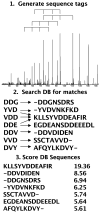GutenTag: high-throughput sequence tagging via an empirically derived fragmentation model
- PMID: 14640709
- PMCID: PMC2915448
- DOI: 10.1021/ac0347462
GutenTag: high-throughput sequence tagging via an empirically derived fragmentation model
Abstract
Shotgun proteomics is a powerful tool for identifying the protein content of complex mixtures via liquid chromatography and tandem mass spectrometry. The most widely used class of algorithms for analyzing mass spectra of peptides has been database search software such as SEQUEST. A new sequence tag database search algorithm, called GutenTag, makes it possible to identify peptides with unknown posttranslational modifications or sequence variations. This software automates the process of inferring partial sequence "tags" directly from the spectrum and efficiently examines a sequence database for peptides that match these tags. When multiple candidate sequences result from the database search, the software evaluates which is the best match by a rapid examination of spectral fragment ions. We compare GutenTag's accuracy to that of SEQUEST on a defined protein mixture, showing that both modified and unmodified peptides can be successfully identified by this approach. GutenTag analyzed 33,000 spectra from a human lens sample, identifying peptides that were missed in prior SEQUEST analysis due to sequence polymorphisms and posttranslational modifications. The software is available under license; visit http://fields.scripps.edu for information.
Figures




Similar articles
-
DirecTag: accurate sequence tags from peptide MS/MS through statistical scoring.J Proteome Res. 2008 Sep;7(9):3838-46. doi: 10.1021/pr800154p. Epub 2008 Jul 17. J Proteome Res. 2008. PMID: 18630943 Free PMC article.
-
DeNovoID: a web-based tool for identifying peptides from sequence and mass tags deduced from de novo peptide sequencing by mass spectroscopy.Nucleic Acids Res. 2005 Jul 1;33(Web Server issue):W376-81. doi: 10.1093/nar/gki461. Nucleic Acids Res. 2005. PMID: 15980493 Free PMC article.
-
Probability-based validation of protein identifications using a modified SEQUEST algorithm.Anal Chem. 2002 Nov 1;74(21):5593-9. doi: 10.1021/ac025826t. Anal Chem. 2002. PMID: 12433093
-
Algorithms for the de novo sequencing of peptides from tandem mass spectra.Expert Rev Proteomics. 2011 Oct;8(5):645-57. doi: 10.1586/epr.11.54. Expert Rev Proteomics. 2011. PMID: 21999834 Review.
-
The spectral networks paradigm in high throughput mass spectrometry.Mol Biosyst. 2012 Oct;8(10):2535-44. doi: 10.1039/c2mb25085c. Mol Biosyst. 2012. PMID: 22610447 Free PMC article. Review.
Cited by
-
MSFragger: ultrafast and comprehensive peptide identification in mass spectrometry-based proteomics.Nat Methods. 2017 May;14(5):513-520. doi: 10.1038/nmeth.4256. Epub 2017 Apr 10. Nat Methods. 2017. PMID: 28394336 Free PMC article.
-
Taking aim at shotgun phosphoproteomics.Anal Biochem. 2008 Apr 1;375(1):1-10. doi: 10.1016/j.ab.2007.11.023. Epub 2007 Nov 22. Anal Biochem. 2008. PMID: 18078798 Free PMC article. Review.
-
Current algorithmic solutions for peptide-based proteomics data generation and identification.Curr Opin Biotechnol. 2013 Feb;24(1):31-8. doi: 10.1016/j.copbio.2012.10.013. Epub 2012 Nov 8. Curr Opin Biotechnol. 2013. PMID: 23142544 Free PMC article. Review.
-
Improved molecular weight-based processing of intact proteins for interrogation by quadrupole-enhanced FT MS/MS.J Proteome Res. 2004 Jul-Aug;3(4):801-6. doi: 10.1021/pr0499489. J Proteome Res. 2004. PMID: 15359734 Free PMC article.
-
MODi: a powerful and convenient web server for identifying multiple post-translational peptide modifications from tandem mass spectra.Nucleic Acids Res. 2006 Jul 1;34(Web Server issue):W258-63. doi: 10.1093/nar/gkl245. Nucleic Acids Res. 2006. PMID: 16845006 Free PMC article.
References
Publication types
MeSH terms
Grants and funding
LinkOut - more resources
Full Text Sources
Other Literature Sources

